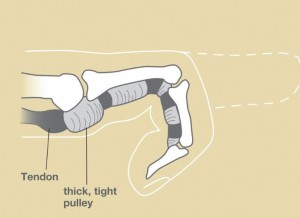Trigger finger is a condition affecting any of the fingers or thumb in the hand — not just the index finger. Symptoms occur when there is catching between the flexor tendons of the hand and the sheath which surrounds the tendons. Instead of gliding smoothly through the sheath, the tendons can meet resistance within the tight sheath, which can be painful and cause the finger to be stiff. Some patients report “catching” or “clicking” or even “locking” in the finger. This can make the hand difficult to use and patients have trouble making a tight fist. Some patients may feel a tender nodule or “bump” in the palm at the base of the finger. In worse cases, the finger can become stuck in flexion, requiring the person the straighten the finger with the other hand. This “unlocking” of the finger can be very painful. These symptoms are often worse in the morning.
What causes trigger finger?
The cause of trigger finger is unknown in most cases. Repetitive, forceful gripping with the hand or trauma may contribute. Sometimes rheumatoid arthritis (RA), diabetes, gout, and thyroid disorders are associated.
Who is at risk for trigger finger?
Trigger finger is 3 times more common in females than males. It typically occurs in people between 40 and 60 years of age. Diabetics and patients with RA have a higher risk. Trigger finger can occur in any finger, and it is also common in the thumb.
What are the treatment options?
Non-operative treatment is tried first. Using a splint at night can reduce swelling and decrease triggering. Resting the hand may also help. Oral anti-inflammatory medications such as Ibuprofen, Naproxen, and Tylenol can help reduce pain and inflammation. A steroid injection (cortisone shot) can fix the problem. I typically recommend trying 2 cortisone shots prior to considering surgery, since the shots can be curative.
If non-operative treatment does not help, surgery is usually recommended. Trigger finger release surgery can be performed to improve the tendon range of motion. During this procedure, the tight sheath (the A1 pulley) is opened through a small incision in the palm and this allows the tendons to glide smoothly. Local anesthesia is typically used, and most patients do not need to be put to sleep for the procedure.
What is the recovery from surgery?
The surgery is performed in a surgery center with local anesthesia. A Valium pill can be used to help with relaxation and anxiety. Patients may use their hands for light activities afterwards. Most people can return to light duty work in a few of days. Normal use of the hand is resumed as comfort permits. The soft surgical bandage can be removed after about 4-5 days. Afterwards the wound should be cleaned and covered with a dry dressing, such as a band-aid. Patients should avoid soaking the hand in a tub or going in a pool, lake, or ocean. The skin sutures are removed in clinic in 10-14 days. I typically recommend avoiding heavy use with the hand for approximately 3-4 weeks after surgery.
What are the results from surgery?
Free gliding of the tendons is noticed soon after surgery. Most patients are very satisfied with their outcome. However, some patients report mild soreness in the palm and stiffness of the finger, which often improve over a few weeks or months. People with hand arthritis are more prone to hand stiffness. Occasionally hand therapy is recommended to improve range of motion and decrease pain. Recurrence of the finger triggering after surgery is very uncommon.

